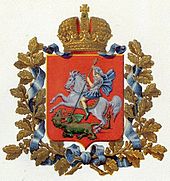Moscow Governorate
The Moscow Governorate ( Russian Московская губерния ) was an administrative unit in the Russian Empire and the Russian SFSR , which existed from 1708 to 1929. It included the area around the capital Moscow , which was also the capital of the governorate. Adjacent governorates were the Tver governorate in the north and north-west, the Vladimir governorate in the north-east and east, the Ryazan governorate in the south-east, the Tula and Kaluga governorates in the south and the Smolensk governorate in the west.
history
The Moscow governorate was created by a decree of Tsar Peter I of December 18, 1708. The establishment of the governorates was accompanied by a number of other measures as part of the Petrine reforms . On May 29, 1719, the governorate was initially divided into nine provinces ( Провинции ); the previously existing administrative unit of the Doli ( доли ) was abolished. These goods:
- Vladimir Province ( Владимирская провинция )
- Kaluga Province ( Калужская провинция )
- Kostroma Province ( Костромская провинция )
- Moscow Province ( Московская провинция )
- Pereslavl- Zalessky Province ( Переслав-Залесская провинция )
- Pereyaslav-Ryazansky Province ( Переяслав-Рязанская провинция )
- Suzdal Province ( Суздальская провинция )
- Tula Province ( Тульская провинция )
- Jurjew-Polski Province ( Юрьево-Польская провинция )
In 1727 the Yaroslavl and Uglich provinces from the St. Petersburg governorate were added.
1775–1778, the governorates of Kaluga, Tula, Tver, Vladimir, Ryazan and Kostroma were formed, which made the governorate smaller and smaller. It received its later form in 1781, from then on it was only divided into Ujesde . So it remained stable until the RSFSR's administrative reform of 1929.
Around 1900 the governorate was divided into 13 Ujesde:
- Bogorodsk (now Noginsk )
- Bronnizy
- Dmitrov
- Clin
- Kolomna
- Moshaisk
- Moscow
- Podolsk
- Rusa
- Serpukhov
- Zvenigorod
- Wereja
- Volokolamsk
The Moscow governorate was not dissolved until the time of the Russian SFSR of the Soviet Union in 1929 and its territory was added to the newly formed Central Industrial Oblast (renamed Moscow Oblast in the same year).
statistics
The first census in the Russian Empire in 1897 counted 2,430,581 inhabitants (72.9 / km²) for the Moscow governorate over an area of 33,304 km². Of these, 2,371,102 were Russians, 19,116 Germans and 10,960 Poles. Otherwise, many other nationalities of the empire were represented in smaller groups.
Agriculture did not meet the needs of the population. The grain harvest in 1902 delivered: 175,955 tons of rye, 125,689 tons of oats, 7117 tons of barley and 402,718 tons of potatoes. Wheat was hardly ever grown , but some flax and hemp and some hops (in Guslizy ). The cultivation of vegetables such as gooseberries, currants and raspberries, as well as onion and cabbage cultivation in some areas, was better developed. The number of cattle, which also did not cover internal needs, was in 1902: 214,000 horses, 274,000 horned cattle, 270,000 sheep and 42,000 pigs. Horse breeding was famous, but was in decline in the early 20th century. In industrial terms, Moscow took first place among all the governorates of the monarchy. According to the 1900 surveys, there were 2,386 factories with a production value of about 350 million rubles and 280,747 workers. Significant factories besides Moscow were Bogorodsk, Sujewo , Orechowo , Kolomna and Serpuchow. In the first place was the cotton industry with 344 factories employing 108,498 workers and producing goods worth 104 million rubles. Cloth manufacture, silk spinning and weaving, dyeing and printing, but especially the chemical industry, in which Moscow also ranks first in Russia, and the machine industry were of greater importance. The house industry was also strongly developed, especially in toys, wood carvings, trimmings and paper mache, which permanently employed around 165,000 people, as well as the traveling trade.
In 1926 there were 4,570,836 inhabitants on 44,569 km² (102.5 / km²).
literature
- Moscow . In: Meyers Großes Konversations-Lexikon . 6th edition. Volume 14, Bibliographisches Institut, Leipzig / Vienna 1908, p. 177 .
Web links
- Results of the 1897 Census (Russian) - Language Groups
- Results of the 1897 Census (Russian) - Counties
- 1926 Census Results (Russian)

